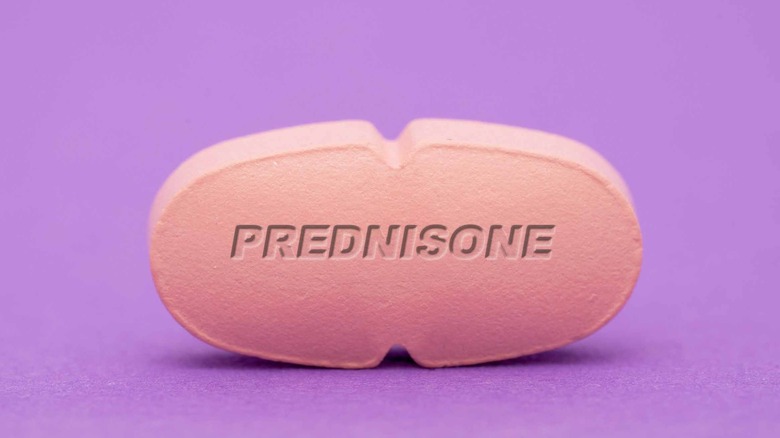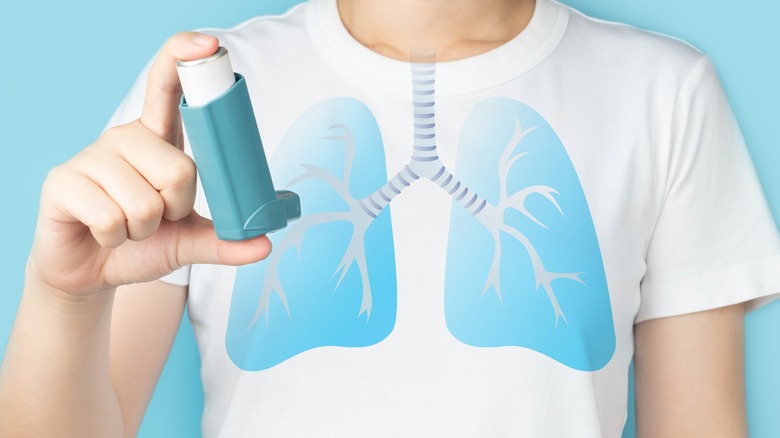This Is How Long It Takes For Prednisone To Start Working
You may have heard the name Prednisone before. Prednisone is a powerful medication used to treat many health conditions related to inflammation. It is in the class of drugs called corticosteroids, also known as steroids (per Cleveland Clinic). Prednisone is not an anabolic steroid, though, which is the kind often used in bodybuilding or to improve athletic performance. Anabolic steroids are manufactured hormones used by healthcare providers to boost levels in those with a deficiency. Some athletes misuse them to boost muscle growth (per MedlinePlus).
Prednisone is used to either boost naturally occurring corticosteroids in patients with low levels, or to treat certain health conditions for people with typical levels (via MedlinePlus). The uses of Prednisone include managing cancer symptoms, arthritis, multiple sclerosis, lupus, severe allergic reactions, blood problems, and breathing problems. It is beneficial because it modifies the immune response and alleviates inflammation.
Since every patient and condition is unique, Prednisone is prescribed in various dosages and forms. These factors all play a role in how long it takes for Prednisone to begin having an effect.
The types of Prednisone
Prednisone is commonly administered as a pill to be swallowed or as an oral liquid solution. It's suggested to be taken with food when prescribed in these forms to prevent any stomach issues. The tablets can come in delayed-release and immediate-release forms (via Medical News Today).
Prednisone can also be administered through an injection. Prednisone injections are used for reducing inflammation in joints or muscles. These can cause issues at the injection site, such as pain, loss of skin color, or skin thinning. Injections are given less frequently and may only be given a few times a year (per Mayo Clinic).
Mayo Clinic notes that inhaled Prednisone can be administered through the nose. This form is used to treat inflammation caused by asthma and nasal allergies. This type of application reduces the amount of excess steroid used and can therefore reduce possible side effects. However, if some of the spray lands in the mouth or throat instead of the lungs, it can lead to discomfort or infection.
Prednisone is used topically as an ointment or cream for dermatological conditions. In this case, it is spread on the skin to help reduce inflammation. Prednisone can also be specifically administered through eyedrops to help reduce eye inflammation, such as in recovery after surgery, notes Mayo Clinic.
How long each type takes to work
Prednisone tablets seem to work reasonably quickly, according to WebMD. When used for arthritis, they can start providing some relief within one to two hours. Liquid solution Prednisone is prescribed similarly to the tablets and therefore should be absorbed and begin to take effect in the same manner, notes Drugs.com.
Currently, the only delayed release form of Prednisone is RAYOS. According to the manufacturer of the delayed-release tablets, the dose releases after about four hours. It should then take effect within one to two hours as described above. The delayed release form is most commonly taken before bed for extended relief overnight, so the patient doesn't need to wake up to administer another tablet.
According to WebMD, Prednisone injections should start having a positive impact within the first 48 hours. The shot's reduction in pain and inflammation will likely last weeks but could be effective even longer.
Regarding topical steroid creams, Dr. Corinna Bowser, an allergist and immunologist with Suburban Allergy Consultants, states via Optum Perks, "We usually see a reduction of itchiness, redness, and inflammation in 1 to 3 days."
When delivered through eye drops, Prednisone should help to relieve symptoms of the affecting condition within five days (per Cleveland Clinic).
Depending on the health condition, the dosage, and your body's response to the treatment, it may take more or less time for Prednisone to kick in.



